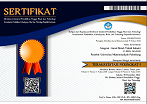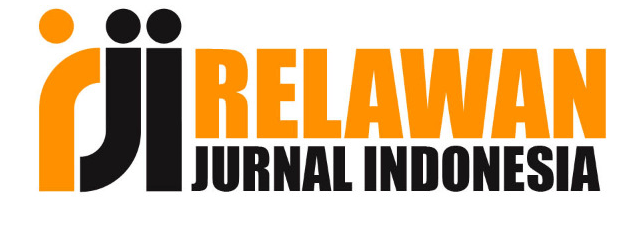Analisis Manajemen Risiko Dengan Penerapan ISO 31000 Pada Proses Machining (Studi Kasus: Perusahaan AB)
Abstract
Perusahaan baik dibidang manufaktur maupun jasa dewasa ini agar bisa bersaing dan berkembang yaitu dengan mempertahankan kualitas produk, melakukan inovasi terhadap produk dan tetap menjaga kepuasan dan kepercayaan konsumen. Untuk dapat menjaga kepuasan dan kepercayaan konsumen tersebut, perusahaan dapat berusaha dengan menghilangkan produk cacat dan menjaga kinerja mereka. Maka untuk dapat mengurangi permasalahan tersebut perusahaan juga dapat menerapkan manajemen risiko untuk mengetahui risiko-risiko apa saja yang teridentifikasi pada produk maupun prosesnya, sehingga penelitian ini bertujuan untuk mengetahui risiko yang muncul pada mesin yang terdapat di Unit Produksi khususnya di Golongan Rangka Bawah, Ruas Roda, Sub Ruang Bongkar Pasang Roda, Perusahaan AB. Metode yang digunakan berdasarkan proses ISO 31000 untuk dapat mengidentifikasi berbagai risiko yang muncul, namun penelitian ini juga menerapkan Failure Mode and Effects Analysis (FMEA) untuk menilai serta memberikan pembobotan pada tiap risiko yang muncul. Hasil yang diperoleh bahwa resiko dengan nilai RPN tertinggi yaitu pada jenis kegagalan akibat dari kontrol operator yang kurang memerhatikan sisa logam pahat pada mesin HG sebesar 180, dengan mitigasi berupa adanya pelatihan terkait dengan SOP mesin, motivasi operator dan pengawasan dari expert atau supervisor itu sendiri. Resiko dengan nilai RPN kedua tertinggi yaitu pada jenis risiko akibat terlalu panas dan gesekan yang kuat pada perangkat roda sebesar 168. Resiko dengan nilai RPN ketiga tertinggi yaitu pada jenis risiko berdasarkan tekanan roda yang terlalu besar sehingga menyebabkan baut pada mesin press kendor sebesar 135, dimana kedua nilai RPN tersebut perawatan secara berkala agar mesin dapat berjalan dengan lancar tanpa hambatan.
Keywords
Full Text:
PDFReferences
E. Pazireh, A. H. Sadeghi, and S. Shokohyar, “Analyzing the enhancement of production efficiency using FMEA through simulation-based optimization technique: A case study in apparel manufacturing,” Cogent Eng., vol. 4, no. 1, pp. 1–12, 2017.
M. Bahrami, D. H. Bazzaz, and S. M. Sajjadi, “Innovation and Improvements In Project Implementation and Management; Using FMEA Technique,” Procedia - Soc. Behav. Sci., vol. 41, pp. 418–425, 2012.
K. Baynal, T. Sari, and B. Akpinar, “Risk management in automotive manufacturing process based on FMEA and grey relational analysis: A case study,” Adv. Prod. Eng. Manag., vol. 13, no. 1, pp. 69–80, Mar. 2018.
J. Tupa, J. Simota, and F. Steiner, “Aspects of Risk Management Implementation for Industry 4.0,” Procedia Manuf., vol. 11, no. June, pp. 1223–1230, 2017.
T. A. Carbone and D. D. Tippett, “Project Risk Management Using the Project Risk FMEA,” Eng. Manag. J., vol. 16, no. 4, pp. 28–35, Dec. 2004.
C. Lalonde and O. Boiral, “Managing risks through ISO 31000: A critical analysis,” Risk Manag., vol. 14, no. 4, pp. 272–300, Nov. 2012.
A. J. Prieto Ibáñez, J. M. Macías Bernal, M. J. Chávez de Diego, and F. J. Alejandre Sánchez, “Expert system for predicting buildings service life under ISO 31000 standard. Application in architectural heritage,” J. Cult. Herit., vol. 18, pp. 209–218, Mar. 2016.
U. R. de Oliveira, F. A. S. Marins, H. M. Rocha, and V. A. P. Salomon, “The ISO 31000 standard in supply chain risk management,” J. Clean. Prod., vol. 151, pp. 616–633, May 2017.
B. Purwanggono and A. Margarette, “Risk assessment of underpass infrastructure project based on IS0 31000 and ISO 21500 using fishbone diagram and RFMEA (project risk failure mode and effects analysis) method,” IOP Conf. Ser. Mater. Sci. Eng., vol. 277, no. 1, p. 012039, Dec. 2017.
F. Shirvani, W. Scott, G. A. L. Kennedy, and A. P. Campbell, “Enhancement of FMEA risk assessment with SysML,” Aust. J. Multi-Disciplinary Eng., vol. 15, no. 1, pp. 52–61, Jan. 2019.
S. N. Waghmare, D. N. Raut, S. K. Mahajan, and S. S. Bhamare, “Validating FMEA and TPM constructs for SMEs in India: a structural equation modelling approach,” Int. J. Indian Cult. Bus. Manag., vol. 14, no. 4, p. 406, 2017.
R. Sawhney, K. Subburaman, C. Sonntag, P. R. Venkateswara Rao, and C. Capizzi, “A modified FMEA approach to enhance reliability of lean systems,” Int. J. Qual. Reliab. Manag., vol. 27, no. 7, pp. 832–855, 2010.
S. Vinodh and D. Santhosh, “Application of FMEA to an automotive leaf spring manufacturing organization,” TQM J., vol. 24, no. 3, pp. 260–274, Apr. 2012.
J. C. Battirola Filho, F. Piechnicki, E. de F. R. Loures, and E. A. P. Santos, “Process-aware FMEA framework for failure analysis in maintenance,” J. Manuf. Technol. Manag., vol. 28, no. 6, pp. 822–848, Jul. 2017.
A. Atkinson, “Human error in the management of building projects,” Constr. Manag. Econ., vol. 16, no. 3, pp. 339–349, May 1998.
M. Jasiulewicz-Kaczmarek, “SWOT analysis for Planned Maintenance strategy-a case study,” IFACPapersOnLine, vol. 49, no. 12, pp. 674–679, 2016.
DOI: https://doi.org/10.32502/js.v6i2.3986
Refbacks
- There are currently no refbacks.

This work is licensed under a Creative Commons Attribution-ShareAlike 4.0 International License.
Diterbitkan oleh Program Studi Teknik Industri, Universitas Muhammadiyah Palembang, Jl. Jenderal A. Yani 13 Ulu Plaju Palembang

Integrasi : Jurnal Ilmiah Teknik Industri is licensed under a Creative Commons Attribution-ShareAlike 4.0 International License.




2.jpg)




